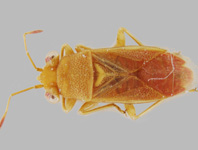Abstract
Liaghinella Wygodzinsky, 1966 (Hemiptera: Heteroptera: Reduviidae: Emesinae: Metapterini), is an endemic Neotropical genus with two described species, one from Jamaica and one from Colombia. In this paper we describe two additional new species from the high Andes in Colombia, Liaghinella heldamariae sp. nov from Monserrate and Villa de Leyva, and L. tuberculata sp. nov. from Chicaque Natural Park, both in the Eastern Cordillera. The new species were collected very close to the type locality of the previously known Colombian species, L. andina Forero, 2007. These two new species differ from L. andina by having both a pair of conspicuous tubercles on the posterior margin of the pronotum, and by the structure of the male and female genitalia. Species diagnosis and descriptions, digital macrophotographies, and a key to separate the species of Liaghinella are presented. A discussion on the small range distributions exhibited by the high Andean species of Liaghinella is provided.
References
Armenteras, D., Gast, F. & Villareal, H. (2003) Andean forest fragmentation and the representativeness of protected natural areas in the eastern Andes, Colombia. Biological Conservation, 113, 245–256.
https://doi.org/10.1016/S0006-3207(02)00359-2
Condit, R., Engelbrecht, B.M.J., Pino, D., Pérez, R. & Turner, B.L. (2013) Species distributions in response to individual soil nutrients and seasonal drought across a community of tropical trees. Proceedings of the National Academy of Sciences, 110, 5064–5068.
https://doi.org/10.1073/pnas.1218042110
Davis, N.T. (1966) Contributions to the morphology and phylogeny of the Reduvioidea (Hemiptera: Heteroptera). Part III. The male and female genitalia. Annals of the Entomological Society of America, 59, 911–924.
https://doi.org/10.1093/aesa/59.5.911Ferrari, A., Barão, K., Michels, F. & Grazia, J. (2015) Classification and Biogeography of Neotropical True Bugs. In: Panizzi, A.R. & Grazia, J. (Eds.), True Bugs (Heteroptera) of the Neotropics. 1st Edition. Entomology in Focus, 2, pp.57−87.
https://doi.org/10.1007/978-94-017-9861-7_3
Forero, D. (2004) Chinches Asesinas de Colombia. In: Fernández, F., Andrade, F. & Amat, G. (Eds.), Insectos de Colombia. Vol. 3. Universidad Nacional de Colombia, Bogotá, pp. 129–275.
Forero, D. (2007) Description of a new species of Liaghinella (Hemiptera: Heteroptera: Reduviidae: Emesinae) from the Colombian Andes, with notes on its feeding habits and conservation status. Zootaxa, 1502, 55–68.
Forero, D. & Weirauch, C. (2012) Comparative genitalic morphology in the New World resin bugs Apiomerini (Hemiptera, Heteroptera, Reduviidae, Harpactorinae). Deutsche Entomologische Zeitschrift, 59, 5–41.
Harvey, M.S. (2002) Short-range endemism amongst the Australian fauna: some examples from non-marine environments. Invertebrate Systematics, 16, 555–570.
https://doi.org/10.1071/IS02009Ishikawa, T. (2002) A new species of the genus Schidium, with notes on the Tribe Metapterini of Japan (Heteroptera, Reduviidae, Emesinae). Japanese Journal of Systematic Entomology, 8 (2), 287–292.
Jardín Botánico de Bogotá (1998) Guía Ecológica Parque Natural Chicaque. Jardín Botánico de Bogotá José Celestino Mutis, 1, 1–27.
Maldonado-Capriles, J. (1990) Systematic Catalogue of the Reduviidae of the World (Insecta: Heteroptera). In: Caribbean Journal of Sciences. Special Edition. University of Puerto Rico, Mayagüez, pp. 1–694.
Merckx, V.S.F.T., Hendriks, K.P., Beentjes, K.K., Mennes, C.B., Becking, L.E., Peijnenburg, K.T.C.A., Afendy, A., Arumugam, N., de Boer, H., Biun, A., Buang, M.M., Chen, P.-P., Chung, A.Y.C., Dow, R., Feijen, F.A.A., Feijen, H., Soest, C.F., Geml, J., Geurts, R., Gravendeel, B., Hovenkamp, P., Imbun, P., Ipor, I., Janssens, S.B., Jocqué, M., Kappes, H., Khoo, E., Koomen, P., Lens, F., Majapun, R.J., Morgado, L.N., Neupane, S., Nieser, N., Pereira, J.T., Rahman, H., Sabran, S., Sawang, A., Schwallier, R.M., Shim, P.-S., Smit, H., Sol, N., Spait, M., Stech, M., Stokvis, F., Sugau, J.B., Suleiman, M., Sumail, S., Thomas, D.C., van Tol, J., Tuh, F.Y.Y., Yahya, B.E., Nais, J., Repin, R., Lakim, M. & Schilthuizen, M. (2015) Evolution of endemism on a young tropical mountain. Nature, 524, 347–350.
https://doi.org/10.1038/nature14949
Moret, P. (2005) Los coleópteros Carabidae del páramo en los Andes del Ecuador. Sistemática, ecología y biogeografía. Monografía 2. Pontificia Universidad Católica del Ecuador, Centro de Biodiversidad y Ambiente, Quito, 306 pp.
Moret, P. (2009) Altitudinal distribution, diversity and endemicity of Carabidae (Coleoptera) in the páramos of Ecuadorian Andes, Annales de la Société entomologique de France, 45 (4), 500–510.
https://doi.org/10.1080/00379271.2009.10697632
Padilla-Gil, D. & Moreira, F. (2013) Checklist, taxonomy and distribution of the Rhagovelia Mayr, 1865 (Hemiptera: Heteroptera: Veliidae) of the Americas. Zootaxa, 3640 (3), 409–424.
https://doi.org/10.11646/zootaxa.3640.3.5
Pimm, S.L., Jenkins, C.N., Abell, R., Brooks, T.M., Gittleman, J.L., Joppa, L.N., Raven, P.H., Roberts, C.M. & Sexton, J.O. (2014) The biodiversity of species and their rates of extinction, distribution, and protection. Science, 344, 1246752.
https://doi.org/10.1126/science.1246752
Prather, C.M., Pelini, S.L., Laws, A., Rivest, E., Woltz, M., Bloch, C.P., Del Toro, I., Ho, C.-K., Kominoski, J., Newbold, T.A.S., Parsons, S. & Joern, A. (2013) Invertebrates, ecosystem services and climate change. Biological Reviews, 88, 327–348.
https://doi.org/10.1111/brv.12002
Samways, M.J., McGeoch, M.A. & New, T.R. (2010) Insect Conservation: A Handbook of Approaches and Methods. Oxford University Press, Oxford, 441 pp.
Särkinen, T., Pennington, R.T., Lavin, M., Simon, M.F. & Hughes, C.E. (2012) Evolutionary islands in the Andes: persistence and isolation explain high endemism in Andean dry tropical forests. Journal of Biogeography, 39, 884–900.
https://doi.org/10.1111/j.1365-2699.2011.02644.x
Schuh, R.T. & Slater, J.A. (1995) True bugs of the world (Hemiptera: Heteroptera): classification and natural history. Comstock Publishing Associates, Cornell University Press, Ithaca, 336 pp.
Weirauch, C. (2008a) Cladistic analysis of Reduviidae (Heteroptera: Cimicomorpha) based on morphological characters. Systematic Entomology, 33, 229–274.
https://doi.org/10.1111/j.1365-3113.2007.00417.x
Weirauch, C. (2008b) From four- to three-segmented labium in Reduviidae (Hemiptera: Heteroptera). Acta Entomologica Musei Nationalis Pragae, 48, 331–344.
Wygodzinsky, P. (1966) A monograph of the Emesinae (Reduviidae, Hemiptera). Bulletin of the American Museum of Natural History, 133, 1–614.

